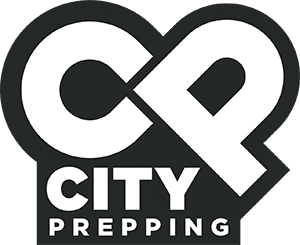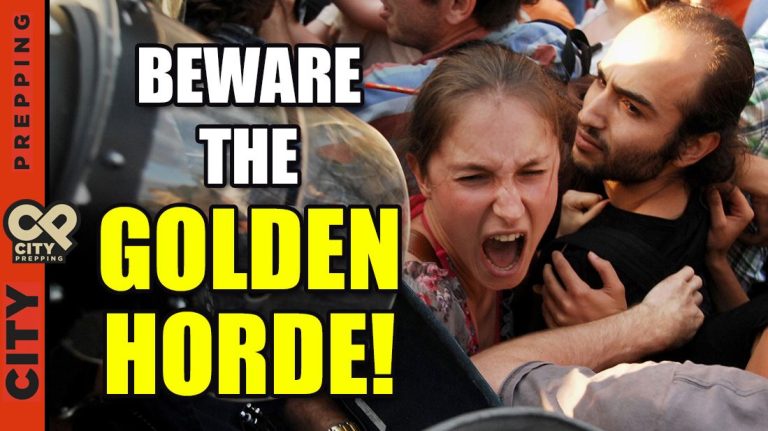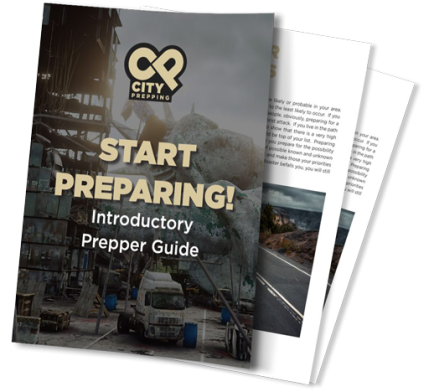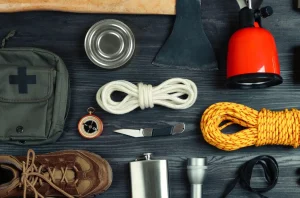“I’m afraid that I won’t do the right thing in the face of disaster.
Or, I’m afraid I will be stupidly brave.”
― Ada Limon, Bright Dead Things
We would like to think that the social norms and laws that we have thoughtfully debated and created over time will hold together the fabric of our civil peace. Still, after a massive SHTF disaster, the peaceful order of our countries and the calm, civil peace, and trust we have in one another will quickly evaporate. You don’t have to look at national-level events to understand how rapidly things can fall apart. Even a small regional event can result in chaos all about you. Some people will be looking simply to survive as they take and steal from others. Some will seize the opportunity that the chaos and destruction present to loot and pillage. Whether out of desperation or with nefarious intent, your chances of being caught up or caught in the crossfire of the chaos are high whether you are locked away in your home, or you are ordered to evacuate an area. Destructive disasters like the Northridge Earthquake, hurricanes Katrina and Andrew, Mount St. Helens, or disasters with prolific death tolls like the Boxing Day Tsunami all had similar factors contributing to the holding up or the breaking down of social order in and around the impacted disaster zone. Whether help and relief response is on the way or no relief is on the horizon will significantly determine how long social order will stand. Regardless of the disaster or death toll, social order will crumble around the edges. This can result in an avalanche of chaos, and you will see the worst, not the best, of humanity, come out. In this video, I will examine the aftermath of large-scale regional disasters to extrapolate a timeline of how the social order will break down in more significant, national, or global SHTF-level events. You need to know whom you can trust, how the social order will unravel, and what you can do to protect yourself. Let’s find out…FACTOR #1: Disaster Extent
 A tornado ripping through the center of your small town isn’t going to lead to a complete breakdown of social order. Emergency services are usually still available around the perimeter of the disaster zone, and there’s an excellent chance your neighbor who was unaffected by the disaster isn’t going to allow someone to just walk away with your big screen TV or arms full of your possessions. I know I wouldn’t hesitate to stop and question someone leaving my neighborhood with what is clearly someone else’s valuables under their arms. I don’t even have to know you personally as a neighbor to extend that courtesy to you. Tornadoes, earthquakes, fires, floods, these all tend to be of your regional variety. There is an established zone of destruction, and the rest of the world is safe. The larger the area, the more likely it is that the social fabric may unravel. An examination of the aftermath of Hurricane Katrina provides insight into how this occurs.
On August 29th at about 6 AM, Hurricane Katrina made landfall as a Category 3 on the Gulf Coast of the United States. By 9 AM, a levee in the Lower Ninth Ward was breached, and the damage went from light to catastrophic. Thousands of people were trapped in attics and rooftops. The day before, then-Mayor of New Orleans, Ray Nagin, had called for a mandatory evacuation, so why were people still there? According to a government hearing on the matter, “the initial evacuation from New Orleans in advance of the storm went relatively well. Approximately 1 million people left the greater New Orleans area in a much more efficient and orderly manner than in hurricane evacuations of years past.” As the assessment goes on, the problem was that those without access to transportation out of the region found themselves stranded. Among those left behind were thousands of elderly, disabled, and disadvantaged residents. Also, in that lot were the simply stubborn. I am sure many of my City Prepping audience can relate. You’re more inclined to hunker down than evacuate, and the government isn’t going to tell you what to do. I mean, many had weathered dozens of hurricanes over their lifetimes, and they knew the drill. None expected the levees to break. National Guard, Police, and other civil forces are stretched too thin to go door-to-door in the moments before a known and approaching disaster, so hundreds if not thousands are left behind in the destructive zone. If the disaster’s approach is unknown, so no evacuation order could be given, everyone is stuck in the disaster zone. The competition for resources in the aftermath is exponentially higher, making your reserves of freshwater, electricity, fire, and food a high-profile target after the stores have been looted.
In the case of hurricane Katrina, 15 to 20 thousand people evacuated to the Super Dome, which began to fill slowly with water, though it remained confined only to the field level. You can imagine the terror and desperation of those trapped in the massive stadium and surrounded by rising floodwaters. It’s no surprise that within 24 hours, the following early morning, as the winds began to dissipate, the looting started.
A tornado ripping through the center of your small town isn’t going to lead to a complete breakdown of social order. Emergency services are usually still available around the perimeter of the disaster zone, and there’s an excellent chance your neighbor who was unaffected by the disaster isn’t going to allow someone to just walk away with your big screen TV or arms full of your possessions. I know I wouldn’t hesitate to stop and question someone leaving my neighborhood with what is clearly someone else’s valuables under their arms. I don’t even have to know you personally as a neighbor to extend that courtesy to you. Tornadoes, earthquakes, fires, floods, these all tend to be of your regional variety. There is an established zone of destruction, and the rest of the world is safe. The larger the area, the more likely it is that the social fabric may unravel. An examination of the aftermath of Hurricane Katrina provides insight into how this occurs.
On August 29th at about 6 AM, Hurricane Katrina made landfall as a Category 3 on the Gulf Coast of the United States. By 9 AM, a levee in the Lower Ninth Ward was breached, and the damage went from light to catastrophic. Thousands of people were trapped in attics and rooftops. The day before, then-Mayor of New Orleans, Ray Nagin, had called for a mandatory evacuation, so why were people still there? According to a government hearing on the matter, “the initial evacuation from New Orleans in advance of the storm went relatively well. Approximately 1 million people left the greater New Orleans area in a much more efficient and orderly manner than in hurricane evacuations of years past.” As the assessment goes on, the problem was that those without access to transportation out of the region found themselves stranded. Among those left behind were thousands of elderly, disabled, and disadvantaged residents. Also, in that lot were the simply stubborn. I am sure many of my City Prepping audience can relate. You’re more inclined to hunker down than evacuate, and the government isn’t going to tell you what to do. I mean, many had weathered dozens of hurricanes over their lifetimes, and they knew the drill. None expected the levees to break. National Guard, Police, and other civil forces are stretched too thin to go door-to-door in the moments before a known and approaching disaster, so hundreds if not thousands are left behind in the destructive zone. If the disaster’s approach is unknown, so no evacuation order could be given, everyone is stuck in the disaster zone. The competition for resources in the aftermath is exponentially higher, making your reserves of freshwater, electricity, fire, and food a high-profile target after the stores have been looted.
In the case of hurricane Katrina, 15 to 20 thousand people evacuated to the Super Dome, which began to fill slowly with water, though it remained confined only to the field level. You can imagine the terror and desperation of those trapped in the massive stadium and surrounded by rising floodwaters. It’s no surprise that within 24 hours, the following early morning, as the winds began to dissipate, the looting started.
FACTOR #2: Looting
 Looting takes two primary forms. First, there are opportunistic people with bad intent to begin with. These are those who, seeing that police services are elsewhere deployed and roads are nearly impassable, will smash the windows and doors of shoe shops, grocery stores, electronic stores, and so forth. Basically, if a person is grabbing a TV out of a store when the power is out, that’s this type of opportunistic person. The second main group is composed of the unprepared. They are more of your desperate variety, but their actions may be just as inexcusable. Having no food or water reserves on hand or it being wiped out in the cataclysmic event, this second group of people must loot or steal to survive. Still lacking long-term planning skills, they grab what they can, even if it sustains them only for the moment. Looting has a zone, as well.
Retail stores and grocery stores are looted first, so these districts are the first impacted. Travel in these districts will become near impossible. And where are the police? Of course, they are providing security where they can, but in the case of Katrina, many police officers failed to come into work and opted to care for their own families at the exclusion of their duties. The size of the store or type of store doesn’t matter to a looter. Typically, the more expensive the item, the more likely it is to be looted. Jewelry and TVs have little value in a disaster, but they’ll be the first to be grabbed. The expensive cuts of meat will be taken in the grocery store long before the dried rice or beans, or Ramen.
Looting can be further delineated based upon need. Is the looting of items that are not immediately needed, like sneakers and TVs, or is the looting desperately needed food and water resources? There can be crossover in the same group of looters. The people looting the pharmacy may consist of those searching for insulin and other critical drugs and your typical drug addict. The degree of looting is a scalable thing that can tell you how dangerous the aftermath of a disaster truly is for you. If it is opportunistic looting, while not safe, it’s safer than looting out of necessity. Those seeking food or water out of desperation are driven more by survival than avarice. As such, they are more likely to take from you without regard. Realize this critical thing, though, when the looting rises to the level of desperation, it is usually long after the looting out of greed has occurred. Where one was looting out of desire before, they will join those stealing out of necessity now.
Despite all the chaos and potential fire threats that can come with looting, you are pretty safe from potential violence or robbery from opportunistic looters. They are more concerned with the easy smash and grab and getaway than they can be bothered with sizing you up and risking their safety to rob you. Also, looting is a group activity. When one looter goes in, he or she gives confidence to the next, and there is a collective sense of “Well, if he is going to get some, I will too.” Looting can turn, though. When the accessible goods are depleted or when a particular thing is in short supply and high demand, people can reason that without any security forces around; they may take their actions to a higher level and rob you of what you have. So, the third factor that determines how things unravel in the aftermath of a disaster is a person’s sense of being observed.
Looting takes two primary forms. First, there are opportunistic people with bad intent to begin with. These are those who, seeing that police services are elsewhere deployed and roads are nearly impassable, will smash the windows and doors of shoe shops, grocery stores, electronic stores, and so forth. Basically, if a person is grabbing a TV out of a store when the power is out, that’s this type of opportunistic person. The second main group is composed of the unprepared. They are more of your desperate variety, but their actions may be just as inexcusable. Having no food or water reserves on hand or it being wiped out in the cataclysmic event, this second group of people must loot or steal to survive. Still lacking long-term planning skills, they grab what they can, even if it sustains them only for the moment. Looting has a zone, as well.
Retail stores and grocery stores are looted first, so these districts are the first impacted. Travel in these districts will become near impossible. And where are the police? Of course, they are providing security where they can, but in the case of Katrina, many police officers failed to come into work and opted to care for their own families at the exclusion of their duties. The size of the store or type of store doesn’t matter to a looter. Typically, the more expensive the item, the more likely it is to be looted. Jewelry and TVs have little value in a disaster, but they’ll be the first to be grabbed. The expensive cuts of meat will be taken in the grocery store long before the dried rice or beans, or Ramen.
Looting can be further delineated based upon need. Is the looting of items that are not immediately needed, like sneakers and TVs, or is the looting desperately needed food and water resources? There can be crossover in the same group of looters. The people looting the pharmacy may consist of those searching for insulin and other critical drugs and your typical drug addict. The degree of looting is a scalable thing that can tell you how dangerous the aftermath of a disaster truly is for you. If it is opportunistic looting, while not safe, it’s safer than looting out of necessity. Those seeking food or water out of desperation are driven more by survival than avarice. As such, they are more likely to take from you without regard. Realize this critical thing, though, when the looting rises to the level of desperation, it is usually long after the looting out of greed has occurred. Where one was looting out of desire before, they will join those stealing out of necessity now.
Despite all the chaos and potential fire threats that can come with looting, you are pretty safe from potential violence or robbery from opportunistic looters. They are more concerned with the easy smash and grab and getaway than they can be bothered with sizing you up and risking their safety to rob you. Also, looting is a group activity. When one looter goes in, he or she gives confidence to the next, and there is a collective sense of “Well, if he is going to get some, I will too.” Looting can turn, though. When the accessible goods are depleted or when a particular thing is in short supply and high demand, people can reason that without any security forces around; they may take their actions to a higher level and rob you of what you have. So, the third factor that determines how things unravel in the aftermath of a disaster is a person’s sense of being observed.
FACTOR #3: Observer Effect
 In the social sciences, there is a hypothesis known as the Hawthorne effect or observer effect. That is the concept that people change their behavior based upon their being watched or their perception that they may be under observation. An astute observer can see this every day from the toddler who grabs something she knows she isn’t allowed because she doesn’t believe her mother is watching to the grown adult who runs the yellow or red light if they are confident there are no police around to write a ticket. The extent of the lawlessness in the disaster area is based upon people’s sense that their actions are unjustifiable to the observer. If someone knows the police will not be coming for at least an hour, that person is more likely to commit a crime. If the person knows police won’t come around for days and days if at all, the likelihood is increased again. If the person in a disaster knows that their crime will likely go unnoticed and without consequence or proof in the future, then the likelihood of committing the crime increases even further. Impunity and lack of accountability can prompt individuals who may be inclined towards criminal activity into acting upon those repressed impulses.
When you walk down the streets in times of complete peace and tranquility, you do so in most countries with the full knowledge and confidence that should anything go wrong, and the police are a phone call away. You know in some instances that some for-hire security may be available simply by raising your voice. You know that should these layers fail, you might rely upon your fellow citizens who might come to your aid or observe and testify on your behalf. Failing all those systems, you know that the National Guard of fellow citizens could come to support you. You understand that the military might be deployed to assist you, keep order, and maintain the peace if your local authorities have lost control. There is layer upon layer of security you enjoy because of the unseen observers ready to step in and bring justice and correctness.
In countries where the military is known for its corruption and its more authoritarian and self-serving actions, they cultivate a different type of observational threat. In Aceh, after the tsunami of 2004, the relief efforts were often hampered by the same military intended to protect the citizenry. According to one province’s mayor, “Due to the ruined access of roads, in the early days, when there was a foreign helicopter delivering aid, the military immediately prevented anyone from taking it even by using violence, and even against children. They kicked the children who were trying to take the milk offered by the foreigners.” Even if your country’s military acts with the best of intentions, a soldier with a gun pointed at looters will dramatically reduce the number of looters. When a looter is shot, the amount of looting will decrease dramatically, or the authority doing the shooting will be tested by the crowds and subsequently feared or overthrown. While people will act differently depending upon whether they feel they are being observed and what repercussions that observation may have on their lives, the fourth factor in determining whether peace can be maintained is the perception of relief and rescue efforts.
In the social sciences, there is a hypothesis known as the Hawthorne effect or observer effect. That is the concept that people change their behavior based upon their being watched or their perception that they may be under observation. An astute observer can see this every day from the toddler who grabs something she knows she isn’t allowed because she doesn’t believe her mother is watching to the grown adult who runs the yellow or red light if they are confident there are no police around to write a ticket. The extent of the lawlessness in the disaster area is based upon people’s sense that their actions are unjustifiable to the observer. If someone knows the police will not be coming for at least an hour, that person is more likely to commit a crime. If the person knows police won’t come around for days and days if at all, the likelihood is increased again. If the person in a disaster knows that their crime will likely go unnoticed and without consequence or proof in the future, then the likelihood of committing the crime increases even further. Impunity and lack of accountability can prompt individuals who may be inclined towards criminal activity into acting upon those repressed impulses.
When you walk down the streets in times of complete peace and tranquility, you do so in most countries with the full knowledge and confidence that should anything go wrong, and the police are a phone call away. You know in some instances that some for-hire security may be available simply by raising your voice. You know that should these layers fail, you might rely upon your fellow citizens who might come to your aid or observe and testify on your behalf. Failing all those systems, you know that the National Guard of fellow citizens could come to support you. You understand that the military might be deployed to assist you, keep order, and maintain the peace if your local authorities have lost control. There is layer upon layer of security you enjoy because of the unseen observers ready to step in and bring justice and correctness.
In countries where the military is known for its corruption and its more authoritarian and self-serving actions, they cultivate a different type of observational threat. In Aceh, after the tsunami of 2004, the relief efforts were often hampered by the same military intended to protect the citizenry. According to one province’s mayor, “Due to the ruined access of roads, in the early days, when there was a foreign helicopter delivering aid, the military immediately prevented anyone from taking it even by using violence, and even against children. They kicked the children who were trying to take the milk offered by the foreigners.” Even if your country’s military acts with the best of intentions, a soldier with a gun pointed at looters will dramatically reduce the number of looters. When a looter is shot, the amount of looting will decrease dramatically, or the authority doing the shooting will be tested by the crowds and subsequently feared or overthrown. While people will act differently depending upon whether they feel they are being observed and what repercussions that observation may have on their lives, the fourth factor in determining whether peace can be maintained is the perception of relief and rescue efforts.
FACTOR #4: Perceptions of Relief & Rescue Efforts
 As I pointed out earlier, there are two distinct types of fires threatening the peace, the fires created by the opportunistic and those created by those acting out of necessity. Both fires are tempered by the perceptions of relief and rescue efforts. If help is on the way, peace is more likely to be maintained. If there is no hope on the horizon, the self-centered motivations that would lead to looting, stealing, robbery, and other crimes and even human rights violations will overtake many people’s rational thinking. If you are trapped by rising floodwaters on the roof of your one-story house, for instance, do you care about whether it is proper and legal for you to float over to your neighbor’s two-story house and punch a hole into his house?
If you know your neighbor has a huge pantry full of food, maybe even preps and long-term stored food, but they were also, you think, out of town when the disaster struck, will you have any problem punching out their glass and getting what you need to survive if you also know that no relief is coming for you? Now, if you don’t know the person, they aren’t even as close to you as a waving neighbor, would you be more likely to take from their supplies to ensure your survival? Even if you still wouldn’t, the typical person wouldn’t hesitate to take what they need from whomever they need to if it means they won’t perish.
Relief and rescue efforts are based upon prior historical experience, as well. If a person was last to receive any aid or assistance before a major disaster struck, they are more likely to push their way to the front of the line in the next disaster or ignore the line altogether to get what they want or need. If aid before was spotty and sparse, they are more likely to grab any supplies given with greater avarice than to be content with a share of what is needed to get by. This can be seen in other disasters where relief efforts require armed security and support, or they would swiftly descend into trampling masses, all clamoring for any grain of rice or drop of water.
As I pointed out earlier, there are two distinct types of fires threatening the peace, the fires created by the opportunistic and those created by those acting out of necessity. Both fires are tempered by the perceptions of relief and rescue efforts. If help is on the way, peace is more likely to be maintained. If there is no hope on the horizon, the self-centered motivations that would lead to looting, stealing, robbery, and other crimes and even human rights violations will overtake many people’s rational thinking. If you are trapped by rising floodwaters on the roof of your one-story house, for instance, do you care about whether it is proper and legal for you to float over to your neighbor’s two-story house and punch a hole into his house?
If you know your neighbor has a huge pantry full of food, maybe even preps and long-term stored food, but they were also, you think, out of town when the disaster struck, will you have any problem punching out their glass and getting what you need to survive if you also know that no relief is coming for you? Now, if you don’t know the person, they aren’t even as close to you as a waving neighbor, would you be more likely to take from their supplies to ensure your survival? Even if you still wouldn’t, the typical person wouldn’t hesitate to take what they need from whomever they need to if it means they won’t perish.
Relief and rescue efforts are based upon prior historical experience, as well. If a person was last to receive any aid or assistance before a major disaster struck, they are more likely to push their way to the front of the line in the next disaster or ignore the line altogether to get what they want or need. If aid before was spotty and sparse, they are more likely to grab any supplies given with greater avarice than to be content with a share of what is needed to get by. This can be seen in other disasters where relief efforts require armed security and support, or they would swiftly descend into trampling masses, all clamoring for any grain of rice or drop of water.







One Response
Great article – there are too many variables to say with certainty how we will each react if a natural or man-made SHTF, TEOTWAWKI, or loss of ROL (Rule of Law) event occurs – we must strive to keep a level head/clear mind and surround ourselves with calm and composed like-minded proactive people we know and trust.
I worked in the Katrina and Rita devastated areas and saw firsthand the huge differences in disaster response from New Orleans and south Texas residents. The areas I worked in south Texas came together and worked as a large team to secure and clean up their neighborhoods, cities, and towns while the occupants of New Orleans and surrounding areas lined up for their freebie handouts. A large majority of those not lined up for freebies were stealing everything that wasn’t bolted down securely. Working in these areas just hours after the storm cleared gave us the information and know-how to tweak our own supplies and responses to bad situations.
I’ve been deep in disaster areas for weeks at a time and what worries me most is not how our group will react but how others that were unprepared react and think they are entitled to take from us that are prepared and surviving.